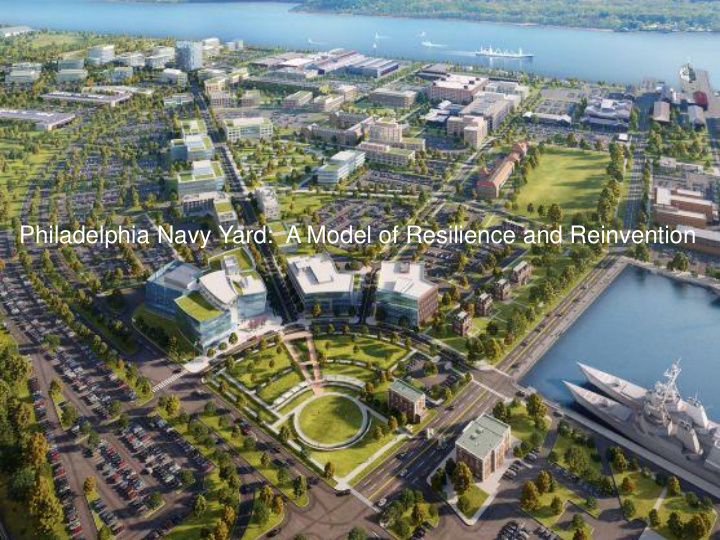



Philadelphia Navy Yard: A Model of Resilience and Reinvention
The Continental Navy is founded in Philadelphia in 1777
Naval Act of 1794 creates U.S. Navy shipyard in Philadelphia Located on Delaware River adjacent to central city
Shipyard enlarges and moves in 1876 to remote League Island at the foot of Broad Street in South Philadelphia Original home on Front Street New home at League Island
U.S. Navy Base and shipyard operate for 120 years, through 1996, at League Island site
Industry at the Navy Yard is an economic engine for Philadelphia which is known as the “Workshop of the World”
At its peak in WW II, the Navy Yard employed 58,000 people In its 200 year history , the Navy Yard built 119 ships.
Many well-known visitors were welcomed at the Navy Yard President Franklin Roosevelt Judy Garland
Base closures of 1991 include Philadelphia Navy Yard – results are devastating for Philadelphia and region More than 18,000 direct and indirect jobs lost Annual loss of over $180 million in direct income Annual loss of $56 million in state and local government revenues Lay-offs resulted in a one-time unemployment cost of $42 million
How to recover: City officials, experts and students engaged in planning and visioning exercises to identify possible reuse
Reviving the Navy Yard required coordinated leadership of government at all levels along with private investors
Potential enhanced by an ideal location in the city and region Centralized location for regional workforce of more than 3 million employees Access to: Major highways International airport Center City University City Intercity rail terminal Sports complex
Master Plan 2004, updated 2013, by RAM Stern Associates
20 years later: Improved infrastructure and a vibrant campus • More than 11,500 employees • 150 companies; 3 Navy activities • In excess of 7 million SF occupied • $750+ million of private investment • $150+ million of publicly funded infrastructure improvements
Campus provides activities and amenities for employees
The Navy Yard is an historic preservation success story Over 30 buildings have been historically renovated. Most preserved buildings are used as office space.
Urban Outfitters world headquarters relocates to the Navy Yard
Renovates abandoned Navy buildings, employs 2,200 people
Reuse of key abandoned dry docks helps build new industries Aker Shipyard manufacturers US merchant shipping vessels
Exploiting unique assets: dry docks for industry and recreation Urban Outfitters campus Aker shipyard
Glaxo SmithKline builds double LEED Platinum offices Navy Yard provides opportunity for more sustainable, flexible work environment than typical downtown high rise building
Tasty Baking Company, largest LEED Silver bakery in the world New, high-efficiency plant moves to 24 hour operation Former Tasty operation in an inefficient multi-story building
LEED certified hotel opens in January 2014, second scheduled Increase in business drives need for hospitality services
Energy Efficiency in Buildings (EEB) hub established in 2010 Consortium of universities and private companies, with federal support, explore ideas for energy efficiency in buildings
New high-technology companies are clustering on the campus Research and industrial facilities for biotech and manufacturing are in construction: Adaptimmune, Axalta and Wuxi Apptec
New infrastructure: storm-water management, solar cells and an unregulated micro-grid for electricity
Central Green Park opens in 2015 creating a new public place
Preparing for the future – more density, better public space
Green space is key to sustainability and long-term resilience
Good plan and patience will complete the Navy Yard over time
Projected economic impact at completion is substantial • 30,000 employees • 1,500 residential units • +15 million SF • $4 billion of investment • $11 billion of local and state impact annually • $275 million of state and local tax revenue annually • Compelling alternative to further-out suburbs • Not a substitute for downtown which has 200,000 employees
Key elements for resilience of the Navy Yard • A good mix of preservation and innovation, re-use and re-invention • Strong public sponsorship around planning, infrastructure and a long-term vision • Strong private sponsorship that invests – resources, credibility and brand identity – to establish market fundamentals • Economic and tax incentives to attract capital • A public-private partnership that provides stewardship and a vehicle for implementation • Commitment to sustainable buildings
Philadelphia thanks the Organization of World Heritage Cities
Recommend
More recommend